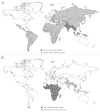Vaccines against invasive Salmonella disease: current status and future directions
- PMID: 24804797
- PMCID: PMC4185946
- DOI: 10.4161/hv.29054
Vaccines against invasive Salmonella disease: current status and future directions
Abstract
Though primarily enteric pathogens, Salmonellae are responsible for a considerable yet under-appreciated global burden of invasive disease. In South and South-East Asia, this manifests as enteric fever caused by serovars Typhi and Paratyphi A. In sub-Saharan Africa, a similar disease burden results from invasive nontyphoidal Salmonellae, principally serovars Typhimurium and Enteritidis. The existing Ty21a live-attenuated and Vi capsular polysaccharide vaccines target S. Typhi and are not effective in young children where the burden of invasive Salmonella disease is highest. After years of lack of investment in new Salmonella vaccines, recent times have seen increased interest in the area led by emerging-market manufacturers, global health vaccine institutes and academic partners. New glycoconjugate vaccines against S. Typhi are becoming available with similar vaccines against other invasive serovars in development. With other new vaccines under investigation, including live-attenuated, protein-based and GMMA vaccines, now is an exciting time for the Salmonella vaccine field.
Keywords: GMMA; Salmonella; enteric; global health; glycoconjugate; nontyphoidal; typhoid; vaccines.
Figures


Similar articles
-
Prospects for prevention of Salmonella infection in children through vaccination.Curr Opin Infect Dis. 2013 Jun;26(3):254-62. doi: 10.1097/QCO.0b013e32835fb829. Curr Opin Infect Dis. 2013. PMID: 23591641 Review.
-
Increasing rates of Salmonella Paratyphi A and the current status of its vaccine development.Expert Rev Vaccines. 2013 Sep;12(9):1021-31. doi: 10.1586/14760584.2013.825450. Expert Rev Vaccines. 2013. PMID: 24053396 Review.
-
Serum bactericidal assays to evaluate typhoidal and nontyphoidal Salmonella vaccines.Clin Vaccine Immunol. 2014 May;21(5):712-21. doi: 10.1128/CVI.00115-14. Epub 2014 Mar 12. Clin Vaccine Immunol. 2014. PMID: 24623629 Free PMC article.
-
GMMA-based vaccine candidates against invasive nontyphoidal salmonellosis elicit bactericidal antibodies against a panel of epidemiologically relevant Salmonellae.Front Immunol. 2025 Jun 20;16:1610067. doi: 10.3389/fimmu.2025.1610067. eCollection 2025. Front Immunol. 2025. PMID: 40625744 Free PMC article.
-
Comparative immunogenicity and efficacy of equivalent outer membrane vesicle and glycoconjugate vaccines against nontyphoidal Salmonella.Proc Natl Acad Sci U S A. 2018 Oct 9;115(41):10428-10433. doi: 10.1073/pnas.1807655115. Epub 2018 Sep 27. Proc Natl Acad Sci U S A. 2018. PMID: 30262653 Free PMC article.
Cited by
-
Outer membrane vesicles derived from Salmonella Typhimurium mutants with truncated LPS induce cross-protective immune responses against infection of Salmonella enterica serovars in the mouse model.Int J Med Microbiol. 2016 Dec;306(8):697-706. doi: 10.1016/j.ijmm.2016.08.004. Epub 2016 Aug 25. Int J Med Microbiol. 2016. PMID: 27578609 Free PMC article.
-
Antibodies and Protection in Systemic Salmonella Infections: Do We Still Have More Questions than Answers?Infect Immun. 2020 Sep 18;88(10):e00219-20. doi: 10.1128/IAI.00219-20. Print 2020 Sep 18. Infect Immun. 2020. PMID: 32601109 Free PMC article. Review.
-
Rotavirus spike protein ΔVP8* as a novel carrier protein for conjugate vaccine platform with demonstrated antigenic potential for use as bivalent vaccine.Sci Rep. 2021 Nov 11;11(1):22037. doi: 10.1038/s41598-021-01549-z. Sci Rep. 2021. PMID: 34764353 Free PMC article.
-
Induction of Hypergammaglobulinemia and Autoantibodies by Salmonella Infection in MyD88-Deficient Mice.Front Immunol. 2018 Jun 20;9:1384. doi: 10.3389/fimmu.2018.01384. eCollection 2018. Front Immunol. 2018. PMID: 29973931 Free PMC article.
-
Induction of Broad Immunity against Invasive Salmonella Disease by a Quadrivalent Combination Salmonella MAPS Vaccine Targeting Salmonella Enterica Serovars Typhimurium, Enteritidis, Typhi, and Paratyphi A.Vaccines (Basel). 2023 Oct 31;11(11):1671. doi: 10.3390/vaccines11111671. Vaccines (Basel). 2023. PMID: 38006003 Free PMC article.
References
-
- Kotloff KL, Nataro JP, Blackwelder WC, Nasrin D, Farag TH, Panchalingam S, Wu Y, Sow SO, Sur D, Breiman RF, et al. Burden and aetiology of diarrhoeal disease in infants and young children in developing countries (the Global Enteric Multicenter Study, GEMS): a prospective, case-control study. Lancet. 2013;382:209–22. doi: 10.1016/S0140-6736(13)60844-2. - DOI - PubMed
Publication types
MeSH terms
Substances
LinkOut - more resources
Full Text Sources
Other Literature Sources
Medical
